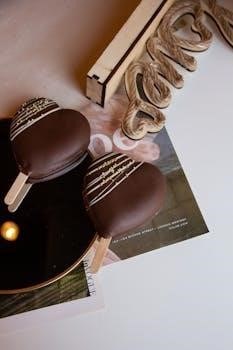Popsicle Stick Catapult Instructions PDF⁚ A Comprehensive Guide
Embark on an engaging journey into the world of simple machines with our comprehensive guide‚ focusing on crafting a popsicle stick catapult. This resource‚ often available as a PDF‚ provides detailed‚ step-by-step instructions perfect for STEM education and hands-on learning. Discover the joy of building and launching!
Popsicle stick catapults offer a fantastic entry point into the world of physics and engineering‚ suitable for learners of all ages. These miniature marvels demonstrate fundamental principles like leverage‚ projectile motion‚ and energy transfer in a tangible and engaging way. Building a popsicle stick catapult is not only a fun activity but also a valuable educational experience. They are simple machines that efficiently move an object from point A to point B.
The beauty of popsicle stick catapults lies in their simplicity. Requiring minimal materials such as popsicle sticks‚ rubber bands‚ and a launching component like a plastic spoon or bottle cap‚ they can be constructed quickly and easily. This accessibility makes them ideal for classroom projects‚ science experiments‚ or even a fun afternoon activity at home.

Moreover‚ popsicle stick catapults can be customized and modified to explore different design variations and their impact on launch distance and accuracy. Whether you’re aiming to launch marshmallows across the room or delving into the physics behind projectile trajectory‚ these little launchers offer endless possibilities for experimentation and discovery. It is a mess-free activity for building catapults without having to run out to the store to buy materials!
Materials Needed for Construction
To embark on your popsicle stick catapult building adventure‚ gathering the necessary materials is the first crucial step. The good news is that most of these items are readily available and inexpensive‚ making this project accessible to everyone. The core component‚ of course‚ is popsicle sticks‚ also known as craft sticks. Jumbo-sized sticks are often preferred for their sturdiness‚ but regular-sized sticks can also be used.
Next‚ you’ll need rubber bands. These provide the essential elastic force that powers the catapult’s launch. The quantity needed may vary depending on the design‚ but having a variety of sizes on hand is always a good idea. To hold the projectile‚ a small container like a plastic spoon or bottle cap is required. These can be easily attached to the launching arm of the catapult.
Finally‚ consider the projectiles you’ll be launching. Mini marshmallows‚ cotton balls‚ pom-poms‚ or even small candies work well and are relatively safe. For securing components‚ super glue or hot glue can be used‚ but adult supervision is recommended when working with these adhesives. With these simple materials‚ you’ll be well-equipped to construct your own popsicle stick catapult and start experimenting with the physics of launching.
Basic Catapult Design⁚ Step-by-Step Instructions
Constructing a basic popsicle stick catapult is a straightforward process‚ perfect for beginners. First‚ gather your materials⁚ popsicle sticks‚ rubber bands‚ a plastic spoon or bottle cap‚ and glue. Begin by creating the base. Stack approximately eight popsicle sticks together and secure them tightly with rubber bands at each end. This forms the foundation of your catapult.
Next‚ prepare the launching arm. Take two popsicle sticks and glue or rubber band them together at one end. Attach your chosen projectile holder – the plastic spoon or bottle cap – to the other end of this arm. Ensure it’s firmly secured to prevent projectiles from dislodging unexpectedly.
Now‚ assemble the catapult. Wedge the launching arm between the top stick and the second stick of the base. This creates the necessary leverage for launching. Use additional rubber bands to secure the launching arm to the base‚ ensuring it’s stable but can still move freely. To launch‚ place your projectile in the spoon or bottle cap‚ pull back on the arm‚ and release. Experiment with different angles and force to adjust the launch distance and accuracy.
Advanced Catapult Design Variations
Once you’ve mastered the basic popsicle stick catapult‚ explore advanced design variations to enhance performance and complexity. One popular modification involves adjusting the lever arm length. By experimenting with longer or shorter arms‚ you can influence the launch distance and projectile trajectory. Another variation includes reinforcing the base with additional popsicle sticks to increase stability and withstand higher launch forces.
Consider incorporating adjustable launch angles. This can be achieved by creating a pivot point that allows you to change the angle of the launching arm relative to the base. Experiment with different types of projectile holders. Instead of a simple spoon or bottle cap‚ try crafting a custom basket or sling for improved projectile control.
For added power‚ explore using stronger rubber bands or even multiple rubber bands in parallel. Remember to reinforce the catapult’s structure to handle the increased tension. Finally‚ consider incorporating a trigger mechanism for more consistent and controlled launches. This could involve a simple latch that releases the launching arm upon activation‚ ensuring repeatable results and improved accuracy. These advanced designs will challenge your engineering skills and lead to more sophisticated catapults.
Understanding the Physics Behind Catapults
The popsicle stick catapult is a fantastic tool for demonstrating fundamental physics principles. At its core‚ a catapult operates based on the principles of energy storage and transfer. When you pull back the launching arm‚ you’re storing elastic potential energy in the rubber bands. This stored energy is then rapidly converted into kinetic energy when the arm is released‚ propelling the projectile forward.
Newton’s Laws of Motion also play a crucial role. The first law‚ inertia‚ explains why the projectile resists movement until a force is applied. The second law‚ F=ma (force equals mass times acceleration)‚ governs the relationship between the force exerted by the catapult‚ the mass of the projectile‚ and its resulting acceleration. A greater force or a lighter projectile will result in higher acceleration and thus greater launch velocity.
The third law‚ action-reaction‚ is evident in the catapult’s stability. The force propelling the projectile forward is met with an equal and opposite force acting on the catapult itself. This is why a stable base is essential for accurate launches; Furthermore‚ projectile motion‚ influenced by gravity and air resistance‚ determines the trajectory and range of the launched object. Understanding these concepts enhances the catapult-building experience;
Optimizing Launch Distance and Accuracy
Achieving maximum launch distance and pinpoint accuracy with your popsicle stick catapult involves a blend of design adjustments and careful execution. The key is to systematically experiment with various parameters and observe their effects on performance. One crucial factor is the angle of launch; typically‚ an angle around 45 degrees provides the optimal balance between height and horizontal distance‚ maximizing range.
The tension and elasticity of the rubber bands also significantly impact launch distance. Tighter rubber bands store more potential energy‚ resulting in a more powerful launch. However‚ excessive tension can reduce accuracy due to instability. Experiment with different rubber band thicknesses and configurations to find the sweet spot. The length and flexibility of the catapult arm are also critical. A longer arm allows for a greater release velocity‚ but it can also be more difficult to control.
Projectile weight plays a significant role; lighter projectiles generally travel further‚ but they are also more susceptible to air resistance. Consistency in projectile size and shape is vital for accuracy. Finally‚ ensuring a stable and level launch platform minimizes unwanted variations in trajectory‚ leading to more consistent and predictable results. By carefully tuning these elements‚ you can significantly improve both the distance and accuracy of your popsicle stick catapult.
Troubleshooting Common Issues
Even with careful construction‚ popsicle stick catapults can sometimes present challenges. One common issue is a lack of launch distance. This often stems from insufficient tension in the rubber bands. Ensure they are tightly secured and consider using thicker bands for increased power. Another frequent problem is inconsistent launch direction. This could be due to an uneven base or a misaligned launch arm. Double-check the catapult’s construction to ensure all components are straight and level.

Projectiles that consistently veer to one side may indicate an imbalance in the launch arm or inconsistent rubber band tension. Adjust the arm’s position or replace the rubber bands to rectify this. If the catapult consistently breaks or falls apart‚ reinforce the joints with additional glue or rubber bands. Consider using stronger craft sticks for critical components. Projectiles occasionally slipping off the launch platform can be resolved by adding a small lip or cup to the end of the arm.

If the launch is weak and the projectile simply dribbles out‚ examine the fulcrum point. Make sure it is securely positioned and provides adequate leverage. Experiment with different fulcrum heights to optimize the launch angle and power. By systematically addressing these common issues‚ you can significantly improve the reliability and performance of your popsicle stick catapult.
Safety Precautions and Considerations
When engaging in popsicle stick catapult construction and operation‚ safety should always be paramount. Firstly‚ eye protection is crucial. Projectiles‚ even lightweight ones‚ can cause injury if they strike the eye. Safety glasses or goggles should be worn by all participants. Secondly‚ establish a designated launch area and ensure that it is clear of people and fragile objects. Never aim the catapult at anyone.
Consider the projectiles themselves. Soft‚ lightweight items like cotton balls or mini marshmallows are preferable to harder‚ more dense objects that could cause harm. Supervise children closely during construction and operation‚ as small parts like rubber bands can be choking hazards. Ensure that glue is used responsibly‚ and avoid contact with skin and eyes.
When testing the catapult‚ start with low-power launches and gradually increase the tension as needed. Be mindful of the catapult’s range and avoid launching projectiles beyond a safe distance. Regularly inspect the catapult for wear and tear‚ and replace any damaged components. Finally‚ emphasize responsible use and respect for others’ safety. By adhering to these precautions‚ you can enjoy the popsicle stick catapult activity while minimizing the risk of accidents and injuries.
Educational Applications and STEM Integration
The popsicle stick catapult offers a fantastic platform for integrating STEM (Science‚ Technology‚ Engineering‚ and Mathematics) principles into education. This simple yet effective project allows students to explore fundamental physics concepts such as projectile motion‚ energy transfer‚ and the laws of motion. By experimenting with different designs and materials‚ students can observe how changes in the catapult’s structure affect its performance‚ reinforcing the scientific method.
The construction process itself encourages engineering skills‚ as students must carefully plan and execute their designs. They learn to troubleshoot problems‚ adapt to challenges‚ and refine their creations. The catapult can also be used to introduce mathematical concepts like angles‚ distances‚ and calculations related to trajectory. Furthermore‚ the project fosters teamwork and collaboration‚ as students work together to build‚ test‚ and improve their catapults.
Beyond the core STEM subjects‚ the popsicle stick catapult can also be linked to broader educational themes. For instance‚ it can be used to explore historical applications of catapults in warfare or to spark discussions about the ethics of weapon design. By connecting the project to real-world scenarios and encouraging critical thinking‚ educators can transform a simple craft activity into a rich and engaging learning experience;
Alternative Projectiles for Catapults
While mini marshmallows are a popular choice for launching from popsicle stick catapults‚ exploring alternative projectiles can significantly enhance the experimental and educational value of the activity. The key is to select projectiles that are safe‚ readily available‚ and offer varying weights‚ sizes‚ and aerodynamic properties.
Soft and lightweight options like cotton balls or pom-poms are excellent for indoor use‚ minimizing the risk of damage or injury. Small candies‚ such as jellybeans or chocolate chips‚ can add a fun‚ edible element to the experiment‚ but it’s crucial to supervise children to prevent overconsumption. For outdoor launches‚ consider using small pebbles‚ dried beans‚ or even rolled-up pieces of paper.
Experimenting with different projectiles allows students to investigate the relationship between projectile mass‚ launch angle‚ and distance traveled. By carefully measuring and recording the results‚ they can gain a deeper understanding of physics principles like momentum and air resistance. Furthermore‚ using a variety of projectiles encourages creativity and problem-solving‚ as students must adapt their catapult design and launch technique to achieve optimal results with each type of ammunition. Remember safety first!
Popsicle Stick Catapult Design Ideas for Kids
Unleash creativity with popsicle stick catapult designs tailored for kids! Begin with a simple lever catapult⁚ stack and bind popsicle sticks for the base‚ then create a launching arm with a spoon attached. This fundamental design introduces basic physics concepts in an engaging way.

For added fun‚ explore variations. Try a taller base for increased launch power‚ or experiment with different fulcrum positions to alter projectile trajectory. Decorate the catapults with paint‚ markers‚ and googly eyes to personalize each creation. Consider themed catapults‚ such as a “castle launcher” adorned with construction paper turrets or a “space blaster” with foil accents.
Encourage kids to modify the designs‚ adding support structures or adjusting the launch angle. Introduce challenges like hitting specific targets or maximizing launch distance. By allowing children to experiment and iterate‚ you foster problem-solving skills and a deeper understanding of engineering principles. Remember‚ the goal is to spark curiosity and inspire a love of learning through hands-on exploration‚ while ensuring safe projectile use‚ like cotton balls‚ is always prioritized!